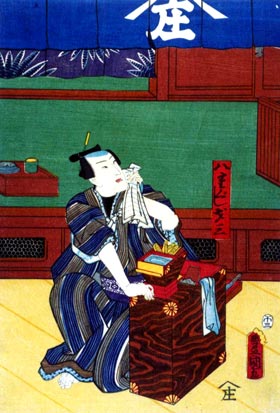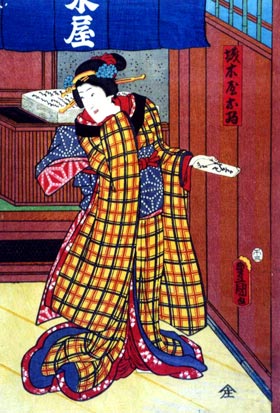| OKOMA SAIZA |
| Play title | Koi Musume Mukashi Hachij˘ |
| Author | Matsu Kanshi |
| History |
The play "Koi Musume Mukashi Hachij˘" was originally written for the puppet theater (Bunraku) and premiered in the 9th lunar month of 1775 in Edo at the Gekiza. It was adapted for Kabuki the following year and staged for the first time in 3rd lunar month of 1776 at the Nakamuraza [casting]. It was based on a real event: the killing of a timber merchant of the district of Shin-Zaimoku-ch˘ (literally the "New Timber Town") in Edo, Shirokoya Matashir˘, who was killed in 1726 by his wife, her mother, a servant and the Shirakoya tedai. The case was investigated by the famous Edo magistrate ďoka Echizen-no-Kami Tadasuke (1677~1751). |
| Structure |
"Koi Musume Mukashi Hachij˘" was originally made up of 5 acts. Only two scenes of the 4th act have survived and are still part of the current Kabuki repertoire: "Shirokiya" (The Shirokiya Timber Store) and "Suzu-ga-Mori" (The Suzu-ga-Mori Execution Ground). |
| Key words |
Kamiyui Keij˘ ďoka-seidanmono ďoka Tadasuke Sewamono Suzu-ga-Mori |
| Summary |
Summary of a previous scene, which is not part of the current Kabuki repertoire, but is important to understand the two others The household of Hagiwara Kurando, a samurai, is trouble-ridden because a teapot cherished as its family treasure is missing. The fact is that Chigusanosuke, younger brother of Kurando, has secretly pawned the pot in order to raise fund for his proposed redemption of a courtesan of the Yoshiwara gay quarters and in the course of this transaction has had the pot swindled. Obana Saizabur˘, son of Obana Rokuroemon, Kurando's chief retainer, hearing servants talk about the household trouble in the garden, scolds them and orders them to go away to work. When Saizabur˘ is alone, Okoma, a maid who is in love with him, appears and tells him that she is sorry because her trysts with him are so scarce. Their secret meeting is detected by Rokuroemon, who scolds Saizabur˘ for his flirtation with a woman in the midst of the household trouble. By way of apology, Saizabur˘ suddenly attempts to kill himself but is dissuaded by Rokuroemon. Rokuroemon deprives Saizabur˘ of his swords and disowns him. Before he is dispelled Saizabur˘ promises his father to do his best to find the lost teapot. Rokuroemon then tells Okoma that he has already obtained his master's permission for her to leave the service in the Hagiwara household and advises her to return to the home of her parents. The young lovers leave the house in tears to go their separate ways. The Shirokiya Timbers Store Okoma now lives with her parents in the Shirokiya timber store. She is perplexed because Sh˘bei, her father, has asked her to marry Tsukudaya Kiz˘, a nouveau riche, from whom Sh˘bei borrowed a lot of money when his house was destroyed in a fire. While she is brooding in the front room of the house, J˘hachi, Sh˘bei's employee, appears and woos her on the false assumption that her reluctance to marry Kiz˘ is due to her love for J˘hachi. Before she can tell him exactly what is in her mind, J˘hachi is called by his employer's wife and goes away. Okoma also enters an inner room. Saizabur˘, who has become a hairdresser, arrives, having been called by Sh˘bei to arrange his hair. He is shocked to hear from a maid that Okoma is going to marry Kiz˘. When Okoma appears he severely accuses her of faithlessness whereupon she asserts that she has no intention of marrying anyone but Saizabur˘. Sh˘bei, who is half blind, then enters and, while having his hair arranged by Saizabur˘, tells Okoma that he was adopted by her late grandfather and married his daughter (Okoma's mother), that he is responsible for maintaining his timber business to which he succeeded upon his foster father's death, and that in order to do so he has to agree to the demand Of Kiz˘, to whom he owes heavily, to marry Okoma. Having had his hair dressed, Sh˘bei withdraws to an inner room. Saizabur˘ and Okoma also withdraw, having noticed the approach of Kiz˘, who apparently has come to make a formal claim to Okoma as his bride. Kiz˘ enters the house and is greeted by J˘hachi. J˘hachi is surprised to find that Kiz˘ is none other than the man with whom he had conspired in swindling the above-mentioned teapot. Kiz˘ hands the teapot to J˘hachi and implicitly asks him not to reveal his clime. After Kiz˘ has entered an inner room, Okoma reappears. J˘hachi proposes to elope together if she does not want to marry Kiz˘. When she declines the offer, he suggests that she poison Kiz˘ to death in the nuptial bed. He runs off to buy the poison. The Suzu-ga-Mori Execution Ground Okoma is now under arrest and has been sentenced to execution at Suzu-ga-Mori for the murder of Kiz˘. She is about to be put to death, being watched by her parents and many spectators staying outside a bamboo fence, when Saizabur˘ appears with J˘hachi, who is tied with cords. He says that it has become known through J˘hachi's confession that Kiz˘ and J˘hachi have conspired to swindle the teapot. He then shows to the execution officials an official letter of pardon for Okoma. Okoma is immediately released to the joy of all those present. Source: Hironaga Shűzabur˘ |
 |
 |
|
The actors Nakamura Fukusuke I and Iwai Kumesabur˘ III
playing the roles of Saiza and Okoma in the drama "My˘-to Musubi Musume Hy˘banki", |
|
|
|
| Contact | Main | Top | Updates | Actors | Plays | Playwrights | Programs | Links | FAQ | Glossary | Chronology | Illustrations | Prints | Characters | Derivatives | Theaters | Coming soon | News |